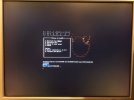First try to install FreeBSD on a MacPro late 2008.
During the installation, in this case FreeBSD 11.4 amd-64, as soon as the first drivers are loaded, I only get stripes on the monitor. The boot process continues in the background, but unfortunately I can't make any inputs without seeing something.
I have tried different graphic cards without success.
My question to you, which boot parameters (loader promt) can I change to get a text?
Thanks for your help!
Frank
During the installation, in this case FreeBSD 11.4 amd-64, as soon as the first drivers are loaded, I only get stripes on the monitor. The boot process continues in the background, but unfortunately I can't make any inputs without seeing something.
I have tried different graphic cards without success.
My question to you, which boot parameters (loader promt) can I change to get a text?
Thanks for your help!
Frank



